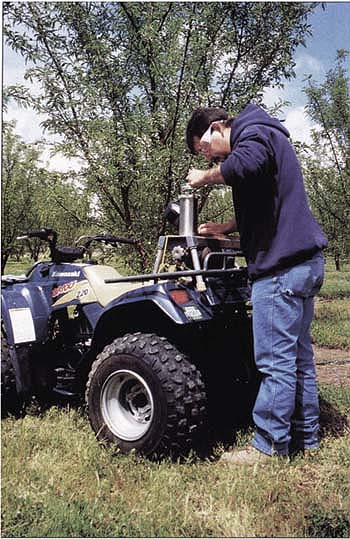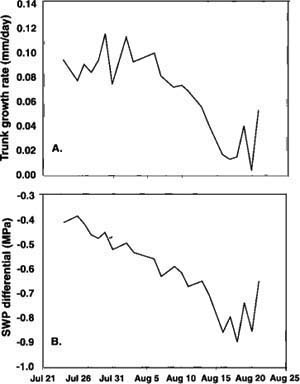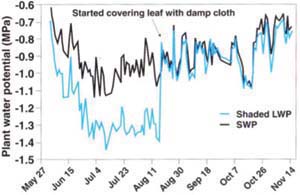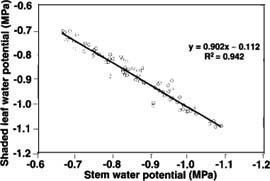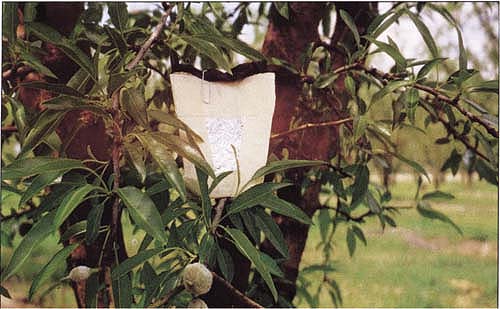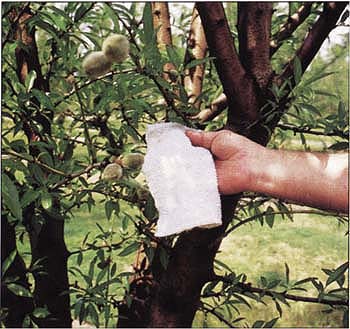All Issues
Simplified tree water status measurements can aid almond irrigation
Publication Information
California Agriculture 55(3):32-37. https://doi.org/10.3733/ca.v055n03p32
Published May 01, 2001
PDF | Citation | Permissions
Abstract
Using tree water status measurements in orchard irrigation management is predicated on the fact that these values are closely linked to important physiological processes, such as growth. In our study, stem water potential (SWP) was highly correlated with vegetative growth in almond trees. However, the SWP technique requires that leaves be covered by small, foil-covered plastic bags for a certain time prior to the pressure chamber measurement and that the atmospheric vapor pressure deficit (VPD) in the orchard be considered in interpreting the data. This can be time consuming and labor intensive for growers. Growers need alternative approaches for taking pressure chamber measurements that are rapid, simple and easy to interpret. We found that measurements of shaded leaf water potential (LWP), taken when the leaf was covered by a damp cloth for the short time between leaf excision and placement in the pressure chamber, correlated well with SWP. Moreover, air temperature at the time of measurement was as useful as VPD for interpreting shaded LWP as an indicator in irrigation management. In addition to weather, this work identified operator differences as a major source of variation in water potential measurements. Plant-based measurements can be useful tools if precautions are taken concerning variability. Shaded LWP has logistical advantages over SWP and this study suggests that it can be used without sacrificing accuracy.
Full text
Elias Fereres (left) and Mario Salinas inspect dataloggers and associated equipment that were used to record daily trunk growth.
The most popular current approaches for almond-orchard water management utilize soil water or weather-related measurements that are only indirectly related to the well-being of the tree and related fruit production. Nevertheless, irrigation scheduling using plant water status assessment is extremely limited in tree crops. The current state of the art in plant water monitoring is measuring stem water potential (SWP). This involves placing a small plastic bag on selected leaves at least 2 hours prior to excising the bag/leaf unit and placing it in a pressure chamber to measure water potential.
The concept is that the bag stops transpiration, which in turn eliminates the water-potential gradient between the leaf and the tree stem and branches. This provides a relatively stable indicator of tree water stress. On the other hand, measurements of the water potential of leaves exposed to sunlight are often more difficult to interpret because variations in leaf sto-mata opening can affect the readings.
Although SWP measurements provide excellent information to help guide irrigation decision-making, bagging leaves for a certain amount of time prior to taking pressure chamber readings, possibly requiring twice-daily trips to the orchard, is time-consuming and labor intensive. Moreover, the current approach to interpreting SWP measurements requires knowing the atmospheric vapor pressure deficit (VPD), which in turn requires knowledge of actual vapor pressure and relative humidity. Although this information can be calculated from weather-station data or using instruments carried to the field, this requires additional time and effort. Alternative approaches are needed for obtaining pressure chamber measurements that are rapid, simple and easy to interpret. Moreover, sources of variability in tree water-status measurements need to be identified and assessed, if possible, to give growers a safety margin when using these indicators in irrigation management.
This paper reports on our efforts to develop user-friendly yet scientifically valid approaches for using tree water potential in irrigation management of almond orchards.
Almond orchard experiments
We established an experimental site in a 4-year-old commercial almond orchard (cv. ‘Price’) in western Kern County. Water was applied daily using a combined system of buried drip lines and microsprinklers. Irrigation amounts were based on calculated orchard evapotranspiration (ETc) using reference crop water use (Eto) and crop coefficients (Kcs). Because our goal was to evaluate different techniques for assessing plant water status and to correlate these measurements with some aspect of atmospheric evaporative demand, we needed trees that were fully irrigated (that is, had no inadvertent deficit irrigation). Therefore approximately 50% more water than ETc was applied to these trees. The orchard was situated on well-drained, sandy, loam soil and no evidence of soil oxygen deficiency was expressed in tree measurements or canopy appearance.
Mario Salinas takes pressure chamber measurements with the console model used in this study. This relatively large type of pressure chamber can be mounted on an all-terrain cycle for easy orchard access.
Glossary
Glossary of acronyms
ETc:: crop evapotranspiration
ETo:: reference (grass) crop water use
Kcs:: crop coefficients
kPa:: kilopascal (unit of water potential)
LVDT:: linear variable displacement transducer
LWP:: leaf water potential
MPa:: megapascal (unit of water potential)
SWP:: stem water potential
VPD:: vapor pressure deficit
Fig. 1. For almond trees subjected to irrigation at 50% ETc (June 16-Aug. 3, 1999) and water deprivation (Aug. 4–19, 1999), (A) trunk growth rate and (B) SWP differential (SWP difference between water-deprived and fully irrigated trees). Each data point is the mean of single measurements on each of four trees.
Fig. 2. Relationship between SWP differential (SWP difference between water-deprived and fully irrigated trees) and trunk growth rate for almond trees subjected to water deprivation (Aug. 4–19, 1999) following irrigation at 50% ETc (June 16-Aug. 3, 1999).
Fig. 3. Pressure chamber measurements using shaded, interior bare leaves (through Aug. 17, 1999) and leaves covered with damp cloth (Aug. 17-Nov. 12, 1999) just prior to excision, compared with stem water potential (SWP). Each data point is the mean of single measurements on each of four trees.
Water status measurements.
Beginning in early June 1999, we began daily (weekday) measurements. We placed small plastic bags covered with foil on the single interior leaves of four trees at each site at about 10 a.m. Starting at 1 p.m., the leaf/bag units were excised and immediately placed in a pressure chamber (Model 3005 Soil Moisture Equipment Co., Santa Barbara, CA) to determine SWP. Pressure chamber readings were taken within 20 seconds of leaf excision. The pressure chamber was also used to measure leaf water potential (LWP) of shaded leaves located in the interior of the tree, again on four single leaves per tree. In 1999, bare leaves were used for the shaded measurements from June through mid-August. For the subsequent measurements in 1999, mid-August through mid-November a damp cloth was placed around the leaves prior to excision. Both the SWP and shaded leaf measurements were made. In 2000, only shaded leaf measurements using the damp cloth were made each weekday beginning in early June through mid-November.
Evaporative demand parameters.
California Irrigation Management Information System (CIMIS) automated weather-station data was used to determine air temperature and to calculate VPD at the average sampling time (2 p.m.). We used data from a station located about 10 miles from our experimental site (Kettleman; No. 21).
Trunk diameter measurements.
To establish the relationship between SWP and vegetative growth, four trees were deprived of irrigation from late July through mid-August in 1999. In addition to measuring SWP, these trees were instrumented with linear variable displacement transducers (LVDTs) to continuously record trunk diameter fluctuations. The daily trunk growth rate was calculated as the daily increase in maximum trunk diameter.
SWP affects growth
The use of plant water-status measurements in irrigation management is based on the fact that these values are closely related to important plant physiological processes, such as vegetative growth. To express the relationship between the trunk growth rate and the SWP of the water-deprived almond trees, we represent SWP as the difference between the stressed and fully irrigated trees and refer to this as the SWP differential. This removes the impact of SWP variability due to daily variations in evaporative demand. The daily trunk growth rate of the stressed trees declined rapidly from about 0.10 mm/day to about 0.01 mm/day within 20 days (fig. 1A). The pattern of SWP differential decline was very similar, declining from -0.4 to -0.9 Megapascal (MPa x 10 = bar units) within the same time period (fig. 1B). These comparable response patterns resulted in a strong linear relationship between the trunk growth rate and the SWP differential (correlation coefficient = 0.809) (fig. 2).
Because growth is one of the most important tree processes in developing an orchard and producing high yields of top-quality fruit, it follows that measurements of SWP, which closely track vegetative growth, should be useful in irrigation management. Nevertheless, adoption of SWP by growers has been limited, and we believe that this is due in part to the logistical problems mentioned earlier.
The bulk of tree transpiration occurs through sunlit leaves on the outside of the canopy. Shaded leaves in the canopy's interior have partially closed stomata and thus very low stomatal conductance. Additionally, the vapor pressure gradient between shaded leaves and the surrounding air is lower than that between sunlit leaves and the air above the tree. Therefore, transpiration from shaded leaves occurs at a very low rate. In theory, this means that the water potential of the shaded leaves would be only slightly lower than SWP. Because measuring shaded LWP has the advantage of requiring only one trip to the field, we investigated using shaded LWP as a tree stress indicator.
Sampling method affects LWP
The sampling method affected the shaded LWP measurements. When bare leaves were sampled, shaded LWP was always lower (more negative) than SWP (fig. 3). However, when a damp cloth was used to cover the leaf between excision and the pressure chamber measurement, shaded LWP was only slightly lower than SWP (fig. 3). Using bare leaves resulted in appreciable leaf dehydration during the 15-to-20-second period between excision and measurement, and therefore in lower LWP values. The damp cloth apparently eliminated most of this dehydration. Moreover, dehydration with uncovered, shaded leaves is time-dependent and individual technicians conduct these measurements at different speeds; this could induce large variations in LWP readings. It is likely that this source of variation would be reduced by covering the leaf with a damp cloth. For the rest of this article, the term “shaded LWP” refers to measurements taken with the damp rag.
We investigated another source of variation by having different operators simultaneously take SWP and shaded LWP measurements on the same trees. Three technicians trained by the same researcher and using the same technique conducted the measurements every 90 minutes from predawn through midday on Aug. 4, 2000. Variation in SWP and shaded LWP values was almost negligible at sunrise, averaged about 0.1 MPa in early morning and reached a maximum of 0.2 MPa at 1 p.m. (figs. 4A, 4B). We believe that the major sources of variation were the speed and methods of handling the sample, so that measurement differences among the operators increased as the evaporative demand increased. These differences were generally statistically significant beginning at the 8:30 a.m. sampling. However, there was a relatively consistent pattern between mean values of both SWP and shaded LWP for each operator following the 8:30 a.m. sampling: technician 1 had the highest (least negative) values, technician 2 had the lowest (most negative), and the measured values of technician 3 fell in between (figs. 4A, 4B). Both SWP and shaded LWP measurements exhibited similar operator variations.
Comparing data taken in 1999 on fully irrigated trees from mid-August through mid-November showed that there was a strong linear relationship (correlation coefficient = 0.942) between shaded LWP and SWP and only a small difference between shaded LWP and SWP of about 0.1 MPa (fig. 5). Clearly, covered and shaded LWP is a good surrogate for SWP.
Other sources of variation
Theoretical and experimental evidence indicates that evaporative demand affects tree water potential. For the period from early June through mid-October 2000, just before orchard dry-down prior to tree shaking, evaporative demand, expressed as VPD, was related to shaded LWP. The linear correlation coefficient was 0.445 (fig. 6A). As VPD increased (hotter and drier weather), shaded LWP decreased. For example, shaded LWP for the fully irrigated trees was -0.67 and -0.90 MPa for VPDs of 1.0 and 5.0 kilopascal, respectively.
The relatively poor correlation and ranges of values suggest that no single value can serve as a reference for the shaded LWP of unstressed trees but that a range of values is needed for different weather conditions. The best-fit linear mathematical equation between shaded LWP and 2 p.m. VPD could be used to calculate the fully irrigated reference value (fig. 6A). However, calculating VPD requires knowing the relative humidity and air temperature at 2 p.m. Air temperature is simple to estimate or measure; relative humidity measurement requires more sophisticated instrumentation. Therefore, we evaluated the relationship between shaded LWP and simply 2 p.m. air temperature (fig. 6B). This relationship had a similar linear correlation coefficient (0.432) as with VPD.
Fig. 4. Diurnal measurements of (A) SWP and (B) shaded LWP conducted on the same four trees by technicians using the same sampling technique on Aug. 4, 2000. Each data point is the mean of single measurements on each of 4 trees. Vertical bars represent two standard errors of the mean.
Fig. 5. Relationship between shaded LWP using damp cloth and SWP for fully irrigated almond trees. Each data point is the mean of single measurements on each of four trees made from mid-August through mid-November 1999.
The fact that only about 45% of the variation in shaded LWP could be attributed to VPD or air temperature indicates that factors other than weather have an important role as sources of variation in shaded LWP measurements. These factors could be related to seasonal physiological and anatomical changes that take place in trees. Leaf water relations change during the season due to osmotic adjustment (accumulation of cellular solutes that influences water transport across cell membranes) and to secondary growth that causes cell walls to become more rigid as the season progresses. Both phenomena change the leaf water potential for a given leaf water content. Xylem cavitation (breakage of water-conducting tissues) in the trunk and branches also increases flow resistance and changes the water potential for the same evaporative demand.
Leaves close to the trunk must be covered by small, foil-covered plastic bags for a period of time prior to measuring stem water potential (SWP).
One advantage of the technique for measuring shaded leaf water potential (LWP) outlined in this paper is that shaded leaves need only be covered by a damp cloth for the the short time between excision and placement of the leaves in the pressure chamber.
Practical use of shaded LWP
Rather than calculating reference values for fully irrigated trees using equations based on VPD or temperature, another approach would be to actually measure water potential on trees specifically maintained by the grower as “fully” irrigated. This could be accomplished with drip/micro-sprinkler systems by adding additional emitters to selected trees to ensure that they received water in excess of ETc. However, excessive irrigation in some poorly drained soils causes anoxia, resulting in poor root health and function. This situation is likely to result in water potential measurements that indicate stressed trees. We believe that calculating reference water potential values based on the research reported here for use in interpreting actual measured values is a better alternative for most growers.
This work has identified two major sources of variation in water potential measurements of fully irrigated trees that growers can take into account: weather and operator. The other sources of variation that we believe exist due to seasonal physiological and anatomical changes in the trees cannot be accounted for at this time. Weather-related variability can be reduced by considering the relationships between shaded LWP and either VPD or air temperature (fig. 6B). Using consistent sampling techniques and personnel when conducting measurements can minimize operator variability. Nevertheless, the considerable unaccounted-for sources of variation create uncertainty in establishing threshold shaded LWP values as precise guidelines for irrigation management of almond orchards. We suggest that the 95% confidence limits developed in this study are good general indicators of the uncertainty of shaded LWP in unstressed almond trees (figs. 6A and 6B).
Fig. 6. Relationship between shaded LWP using damp cloth and (A) atmospheric vapor pressure deficit (VPD) and (B) air temperature at the 2 p.m. sampling time for fully irrigated almond trees. Each data point is the mean of single measurements on each of four trees taken from early June through mid-October. Dashed lines are the 95% confidence limits.
We believe that plant-based measurements of tree water status can be useful tools in the irrigation management of almond orchards if precautions are taken concerning variability. The strong correlation between SWP and shaded LWP suggests that the latter measurement, which has logistical advantages (including no need for bags or making two trips to the field and not having to determine VPD) can be useful without sacrificing accuracy. The similar relationships between shaded LWP and both VPD and air temperature indicate that one does not have to calculate VPD to establish reference values but simply consider air temperature at the time of measurement. These advantages make tree water potential measurements easier to take and interpret than SWP, which should encourage grower adoption of this technique.
The availability of the more portable “pump-up” pressure chambers and increased awareness of how good water management can save energy are additional motivations for using plant-based measurements in irrigation scheduling.




